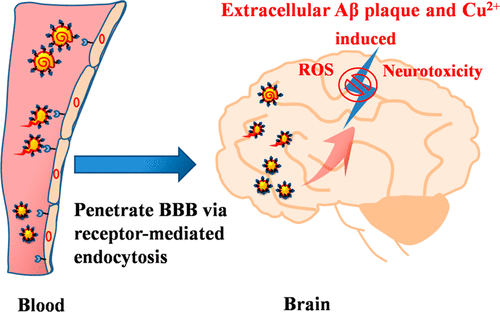当前位置:
X-MOL 学术
›
ACS Chem. Neurosci.
›
论文详情
Our official English website, www.x-mol.net, welcomes your
feedback! (Note: you will need to create a separate account there.)
Sulfur Nanoparticles with Novel Morphologies Coupled with Brain-Targeting Peptides RVG as a New Type of Inhibitor Against Metal-Induced Aβ Aggregation
ACS Chemical Neuroscience ( IF 4.1 ) Pub Date : 2017-12-01 00:00:00 , DOI: 10.1021/acschemneuro.7b00312 Jing Sun 1 , Wenjie Xie 1 , Xufeng Zhu 1 , Mengmeng Xu 1 , Jie Liu 1
ACS Chemical Neuroscience ( IF 4.1 ) Pub Date : 2017-12-01 00:00:00 , DOI: 10.1021/acschemneuro.7b00312 Jing Sun 1 , Wenjie Xie 1 , Xufeng Zhu 1 , Mengmeng Xu 1 , Jie Liu 1
Affiliation

|
Functionalized nanomaterials, which have been applied widely to inhibit amyloid-β protein (Aβ) aggregation, show enormous potential in the field of prevention and treatment of Alzheimer’s disease (AD). A significant body of data has demonstrated that the morphology and size of nanomaterials have remarkable effects on their biological behaviors. In this work, we proposed and designed three kinds of brain-targeting sulfur nanoparticles ([email protected]@SNPs) with novel morphologies (volute-like, tadpole-like, and sphere-like) and investigated the effect of different [email protected]@SNPs on Aβ–Cu2+ complex aggregation and their corresponding neurotoxicity. Among them, the sphere-like nanoparticles ([email protected]@SS) exhibited the most effective inhibitory activity, due to their unique mini size effect, and they reduced 61.6% the Aβ–Cu2+ complex aggregation and increased 92.4% SH-SY5Y cell viability in a dose of 10 μg/mL. In vitro and in vivo, the abilities of different morphologies of [email protected]@SNPs to cross the blood–brain barrier (BBB) and target brain parenchymal cells were significantly different. Moreover, improvements in learning disability and cognitive loss were shown in the transgenic AD mice model using the Morris water maze test after multiple doses of [email protected]@SNPs treatment. In general, the purpose of this research is to develop a biological application of sulfur nanoparticles and to provide a novel functionalized nanomaterial to treat AD.
中文翻译:

具有新型形态的硫纳米颗粒与脑靶向肽RVG结合,作为新型的金属诱导的Aβ聚集抑制剂
功能化的纳米材料已被广泛应用于抑制淀粉样β蛋白(Aβ)的聚集,在预防和治疗阿尔茨海默氏病(AD)领域显示出巨大的潜力。大量数据表明,纳米材料的形态和尺寸对其生物学行为具有显着影响。在这项工作中,我们提出并设计了三种具有新颖形态(蜗壳状,t状和球状)的靶向脑的硫纳米颗粒([电子邮件保护] @SNPs),并研究了不同的[电子邮件保护的] ] @Sβ在Aβ–Cu 2+上复杂的聚集及其相应的神经毒性。其中,球形纳米颗粒([email protected] @SS)由于其独特的微小尺寸效应而表现出最有效的抑制活性,并且它们减少了61.6%的Aβ–Cu 2+剂量为10μg/ mL时,复合物聚集并增加了92.4%的SH-SY5Y细胞活力。在体外和体内,[email protected] @SNP的不同形态穿过血脑屏障(BBB)和靶向脑实质细胞的能力显着不同。此外,在使用多剂量[电子邮件保护] @SNPs治疗后,使用莫里斯水迷宫测试在转基因AD小鼠模型中显示出学习障碍和认知丧失的改善。通常,该研究的目的是开发硫纳米颗粒的生物学应用,并提供一种新型的功能化纳米材料来治疗AD。
更新日期:2017-12-01
中文翻译:

具有新型形态的硫纳米颗粒与脑靶向肽RVG结合,作为新型的金属诱导的Aβ聚集抑制剂
功能化的纳米材料已被广泛应用于抑制淀粉样β蛋白(Aβ)的聚集,在预防和治疗阿尔茨海默氏病(AD)领域显示出巨大的潜力。大量数据表明,纳米材料的形态和尺寸对其生物学行为具有显着影响。在这项工作中,我们提出并设计了三种具有新颖形态(蜗壳状,t状和球状)的靶向脑的硫纳米颗粒([电子邮件保护] @SNPs),并研究了不同的[电子邮件保护的] ] @Sβ在Aβ–Cu 2+上复杂的聚集及其相应的神经毒性。其中,球形纳米颗粒([email protected] @SS)由于其独特的微小尺寸效应而表现出最有效的抑制活性,并且它们减少了61.6%的Aβ–Cu 2+剂量为10μg/ mL时,复合物聚集并增加了92.4%的SH-SY5Y细胞活力。在体外和体内,[email protected] @SNP的不同形态穿过血脑屏障(BBB)和靶向脑实质细胞的能力显着不同。此外,在使用多剂量[电子邮件保护] @SNPs治疗后,使用莫里斯水迷宫测试在转基因AD小鼠模型中显示出学习障碍和认知丧失的改善。通常,该研究的目的是开发硫纳米颗粒的生物学应用,并提供一种新型的功能化纳米材料来治疗AD。











































 京公网安备 11010802027423号
京公网安备 11010802027423号